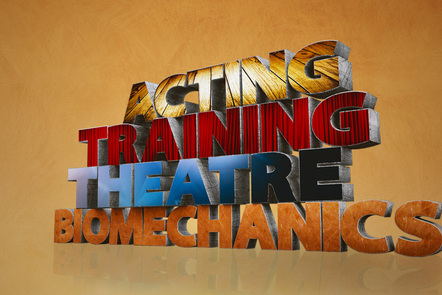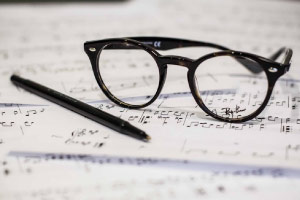Online courses directory (215)
This seminar introduces, through studio projects, the basic principles regarding the use of color in the visual arts. Students explore a range of topics, including the historical uses of color in the arts, the interactions between colors, and the psychology of color.
This Graphic Design course builds on the introductory course and investigates the application of graphic design principals in the production process such as composition, balance, contrast and hierarchy. It is suitable for students studying graphic design, and designers and artists working in the graphic design industry. <br />
Explore the history and practice of physical theatre training using internationally recognised approach to acting: biomechanics.
This course is a technical ear training programme designed to improve critical listening in a music studio context.
This course serves as an introduction to the Buddhist artistic traditions of South, Southeast, and East Asia, as well as the Himalayas. It is organized into four units based on the development of Buddhist schools and artistic traditions in Southeast Asia, the Himalayas, and China, Korea, and Japan. The first unit surveys the core tenets of Buddhism, Buddhist iconography, and early Buddhist art and architecture in India. The second unit reviews the development of Buddhist art and architecture in Southeast Asia, focusing on the patronage of Theravada and Mahayana Buddhism by rulers in the modern countries of Indonesia, Cambodia, Myanmar, and Thailand. Unit three examines the particular form of Vajrayana Buddhism and its artistic traditions that developed in the Himalayas. The final unit traces the spread of Mahayana Buddhist art and architecture into China and later into Korea and Japan via the Silk Roads. All four units highlight the interaction between Buddhist doctrine, art, and architecture; Bud…
In common conversation, we often use the phrase “contemporary art” to refer to current artistic productionthe art being produced today. However, in the art history field, the phrase denotes a specific period of art and artistic practice starting in the 1960s and continuing today. It is characterized by a break from the modernist artistic canon and a desire to move away from the dominant Western cultural model, looking for inspiration in everyday and popular culture. More specifically, many contemporary artworks reject traditional modernistic artistic media (such as painting or sculpture) in favor of a more collaborative, ephemeral, and multimedia approach that further blurs the boundaries between high and mass culture. In its subject matter, this art also tends to reflect a shift away from purely aesthetic issues to more socially oriented concerns. Finally, it is important to note that contemporary art should not be seen as a progression of different artistic styles but as series of different cu…
In this course, we will study the architecture of Ancient Rome, beginning with its origins in the eighth century BC, and continuing through the fourth century AD with the move of the Roman capital to Constantinople. The course of lectures and readings outlined below will familiarize you with the major building methods and styles used in Roman architecture. In addition, interior decoration (including the very important topic of Roman wall painting) will be addressed. By the end of the course, you will be able to identify some of the most important works of Roman architecture and discuss the historical and cultural conditions that informed their production. An important theme throughout the first half of the course is the relationship between Ancient Rome and Greek and Etruscan cultures, which were highly influential in the formation of a distinctive Roman architecture. Understanding the role that Roman architecture played in the eastern and western Roman provinces is also significant to this course,…
This course provides an introductory survey of the Western classical tradition, exploring music both as a phenomenon of sound and culture. The focus of this course is the development of aural skills that lead to an understanding and appreciation of music. Making use of live performances and streaming audio available on the Internet, we will listen to and explore some of the most important and influential repertoires and genres of music that emerged in the last four centuries: High Renaissance vocal music, the cantatas and oratorios of Bach and Handel, Mozart’s comic operas, the monumental orchestral works of the Romantic movement, and the major musical movements of twentieth-century Europe and America, revealing significant connections with contemporary pop and jazz styles. These styles have become an enduring part of the world of music in the twenty-first century, traveling out of the concert hall and conservatory into the larger world via movies, television, and the Internet. This course will begi…
Music theory, one of our top online music classes, is the analysation of how music works - by studying the notation and language of music. Unlike other online music lessons, Introduction to Music Theory introduces the basic concepts and terms needed to discuss melody and harmony. Concepts covered include interval, major and minor keys and scales, triads, chords and beginning harmonic analysis.<br />The course is suitable for teens or adults with no background in music theory but some familiarity with reading common notation and playing an instrument (or singing).<br />
Through a progressive series of composition projects, students investigate the sonic organization of musical works and performances, focusing on fundamental questions of unity and variety. Aesthetic issues are considered in the pragmatic context of the instructions that composers provide to achieve a desired musical result, whether these instructions are notated in prose, as graphic images, or in symbolic notation. No formal training is required. Weekly listening, reading, and composition assignments draw on a broad range of musical styles and intellectual traditions, from various cultures and historical periods.
This course is presented in Mandarin.
If you are having difficulty viewing this video in mainland China, you can also find it here.
课程介绍视频也可以访问中国网站
点击上方绿色按钮报名。
通 过此课程,学生将对民俗学有一个初步的认识,对民俗的起源、产生和发展,民俗的基本分类,民俗与文化,民俗与生活,民俗与国民性等诸多问题,以及民俗在文 化保持和传承中的重要作用有一个较为全面的了解。 此课程不需要先修课程,对民俗与文化感兴趣的学生均可选修此课程。 课程学习时间为11周。学生选修此课程需要按要求观看课程视频,阅读指定参考资料。为全面掌握课程讲述内容,学生需要花费4小时左右阅读教师布置的阅读作 业。 课程期末考核包括两部分内容,一是学生需按要求完成民俗采风的作业,二是期末参加在线考试,分别占最后成绩的50% 此课程的教材为《民俗学概论》(第二版),王娟著,北京大学出版社,2011年。
This eleven-week course will provide students with the basic knowledge of folklore, including its history, classification, function, and value. Coursework will include videos, readings, and an assignment of collecting 20 items of folklore. There will also be a final exam.
The course is one of the PKU-DeTao MOOCs, which is a joint effort by Peking University and DeTao Masters Academy. 该课程是“北大-德稻网络开放课程”中的一门,由北京大学与德稻教育联合提供。"
Build your earth science vocabulary and learn about cycles of matter and types of sedimentary rocks through the Education Portal course Earth Science 101: Earth Science. Our series of video lessons and accompanying self-assessment quizzes can help you boost your scientific knowledge ahead of the Excelsior Earth Science exam . This course was designed by experienced educators and examines both science basics, like experimental design and systems of measurement, and more advanced topics, such as analysis of rock deformation and theories of continental drift.
[IF YOU ARE LOOKING FOR THE NO-CREDIT ON-DEMAND VERSION OF THIS COURSE PLEASE GO TO https://www.coursera.org/learn/symmetry]. Learn how to identify symmetrical forms and appreciate their importance in nature, art, architecture, crystallography and technology. Understand symmetry quantitatively, recognize its role in beauty and design, and appreciate its function in our everyday life. The level of difficulty is intermediate-to-hard with a workload is 7-10 hrs/week. This MOOC is for credit, and students who obtain a Verified Certificate by submitting and authenticating at least 8 out of the 9 assignments with an overall mark of more than 60%, earn 3 Academic Units (AU) that can be directed towards either an Unrestricted Elective (UE) or General Elective (GE-STS) subject at NTU. The usual NTU examination procedure requires student identification through webcam plus keystroke patterning for each assignment submission with a no-tolerance policy towards cheating (https://www.coursera.org/about/terms/honorcode and http://www.ntu.edu.sg/SAO/Pages/HonourCode.aspx). Students who are found to cheat, tamper with or falsify grades, or collude on assignments will be denied credits. It is not necessary to be enrolled at NTU to be awarded 3 AU and once received the AU remain valid 3 years. Because this is a for-credit course students must join the Signature Track stream within the first 2 week add-drop period (up to 22 January 2016, 2359 hrs) in accordance with NTU rules.
Louis Armstrong. Charlie Parker. John Coltrane. You’ve heard their names, but do you know what makes them great? In Jazz Appreciation, you will learn what these artists and many others contributed to America’s great original art form, revered the world over for its innovation and creativity. Jazz emerged during a time of tremendous change and upheaval in American society; this course will also discuss how its evolution both reflected and contributed to those changes.
Much more than a lecture series, Jazz Appreciation weaves in musical performances and examples that will deepen your understanding of the musical process and develop your ability to identify and analyze different jazz eras and great jazz soloists. It also incorporates cutting-edge adaptive learning technology that will allow you to practice your new knowledge and skills, at your own pace, until you reach mastery.
Join this course to enhance your enjoyment of jazz by developing an informed understanding and deep appreciation of the art.
Please note: This course includes a wealth of music. In sensitivity to artists’ rights, course videos including music are available for a limited time only. Materials are released weekly on Saturday mornings, and videos are removed nine days later, on Sunday nights. Please plan to keep pace with the course in order to get the most out of it.
The beginning of the 21st century has been called the Information Age because of rapid increases in information and information resources. Information literacy is now a core competency mandated by higher education accreditation associations for almost all U.S. colleges and universities. It goes far beyond simple web searches and equips students with the research skills necessary to find, evaluate, and appropriately use the types of information required for college level research. This course is geared toward college students, especially those majoring in art and design, but will be useful to anyone who wants to become a more effective searcher. Students will explore the “deep web” (information not found through search engines) and experiment with various search strategies and filtering techniques. Students will also be encouraged to explore resources found in local libraries.
基于20世纪西方音乐,什么是音乐、什么是20世纪西方音乐及什么是有效聆听为全课核心线索,引导学生发展美感能力,促进其全面聆听能力的培养。The course aims to provide a clear view of the historical development of music and emphasizes the training of aural skills.
Arts and culture leaders have a rewarding but tough task: creating sustainable organizations that deliver real social value. There is a lot of competition out there. Being an effective leader means constantly adapting, cleverly using the best tools to reach as many people as possible. This course is designed to help leaders at any level do just that.
This course is devoted to the life and work of distinguished culinary professionals of the recent past and the present who have changed the way we eat and drink in the United States. Some are well-known to the public, others less so, but they all have left a long-lasting mark on what and where Americans eat, how they cook, and even the way they think and talk about food.
This Art History course investigates the role of the French avant-garde in developing and showcasing new modern forms and approaches to art and visual culture in the 19th century. The material addresses the most critical issues of modernity from Realism through Post-Impressionism. We will cover the stylistic changes that challenged academic art, the new subjects that confounded modern audiences, and the new roles and authority of the modern artist. To do this, we will focus on the European world through a series of video podcasts and online readings over five weeks. By the end of the course, you will understand the issues of modernity and the way that art and art-making addressed these issues as well as recognize the profound impact that 19th century Europe had in shaping our contemporary ideas of being “modern.”
At its core, this course is about providing students with a broader understanding of music as a uniquely human activity. This will be accomplished by discussing the music you actually listen to, learning about various dimensions and elements of music, and creating your own music. No previous experience making music is necessary. This course is designed for individuals at all levels of musical understanding and experience. The fundamental assumption underlying the course design is that ALL people are innately musicians, whether that musicianship is expressed in the form of listening, performing, or creating music. Ever since you were born (and even before) you have been developing an expertise in music based on your own personal musical experience. This is similar to how you have been developing a language expertise that is dependent on your individual experience with the language(s) that you speak. It is your own individual musical expertise that forms the entry point into this course and on which this course is built. These are the course’s four learning goals: Acquire a more robust understanding of the various dimensions of music Acquire a richer language for talking about (describing and evaluating) music Integrate those understandings to create and evaluate your own music Apply this musical language to describe and evaluate music of others The entire course is framed around answering one basic, but deceptively complex, question: What is music? The course is structured to help answer this question by approaching it from various perspectives, including the following: Music as Human Activity Music as Metaphor Music as Emotion Music as Physics Music as Form Music as Culture Within each module, you will do each of the following: Learn new material through various media, including course readings, presentations, videos, websites, etc. Actively participate in discussions, which are designed to give you opportunities to apply and broaden your knowledge of this new material. Demonstrate your knowledge by completing short quizzes on the material (only some modules). Create musical products of your own, with support and help embedded within the course itself (you do NOT need to be able to play an instrument or have previous experience making/writing music). Review, evaluate, critique, and discuss projects from your peers.
Trusted paper writing service WriteMyPaper.Today will write the papers of any difficulty.
















